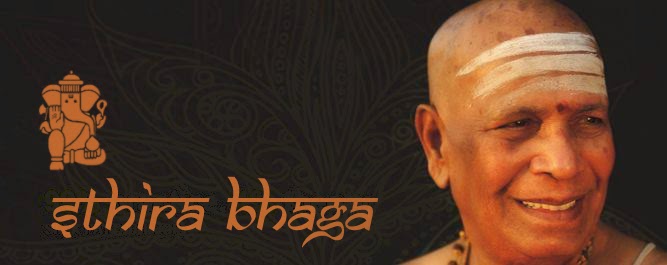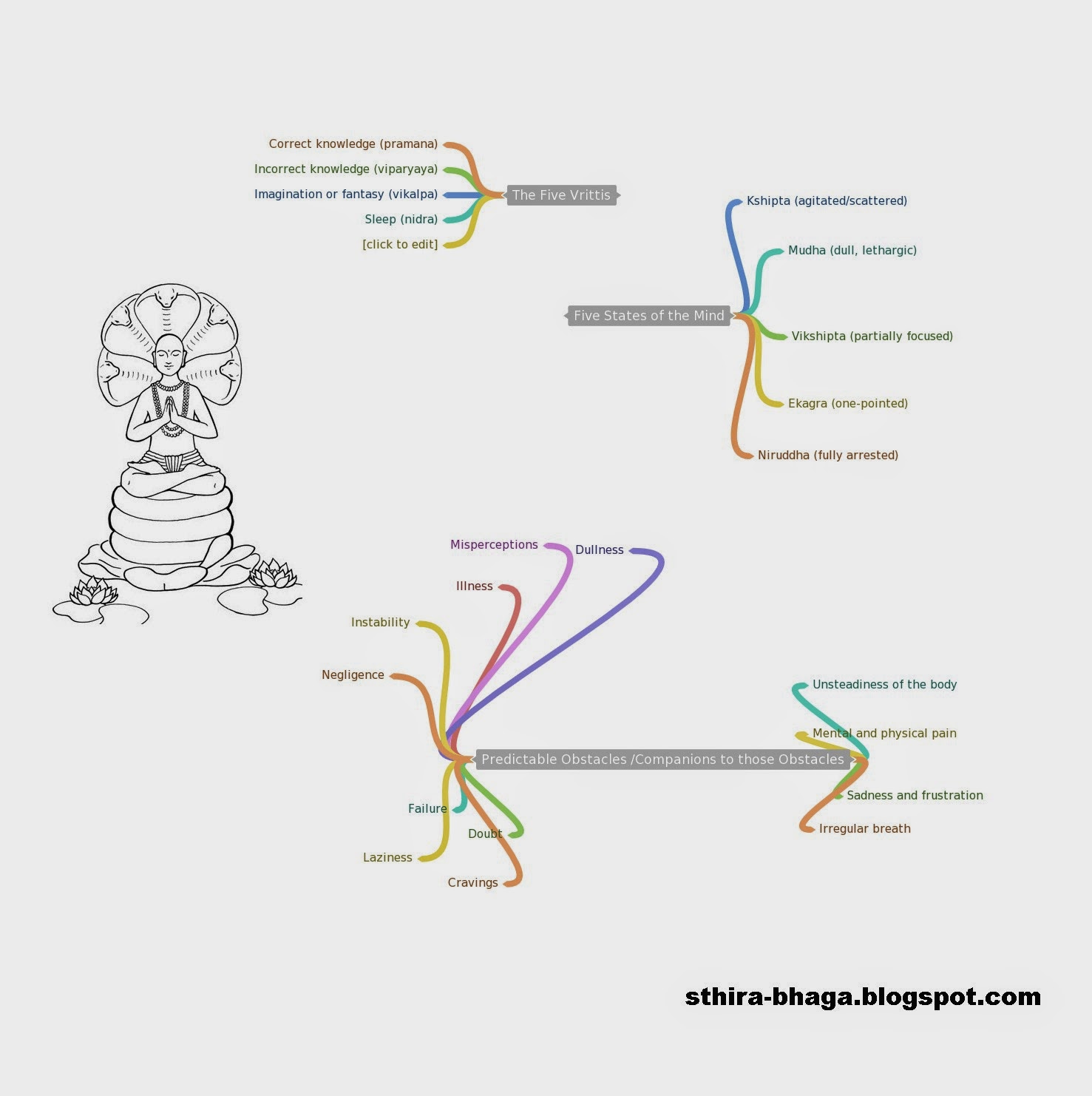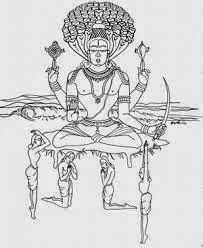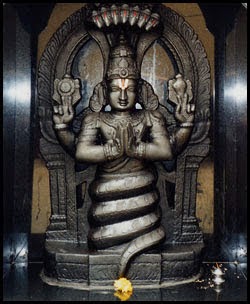Páginas
- Pàgina d'inici
- Clases de Ashtanga en Tarragona
- Library
- My practice
- My practice videos
- Ashtanga series
- Ashtanga pranayama sequence
- Pranayama
- Asana
- Yoga meditation
- Mudra&Bandha and Kriya
- Mantra
- Moon days
- Oil bath
- Clips
- Audio/pdf book
- Zen and Vipassana Meditation
- Index
- interviews for Sthira&Bhaga
- textos propios
miércoles, 30 de julio de 2014
lunes, 28 de julio de 2014
domingo, 27 de julio de 2014
the nine distractions for the mind (Patanjali)
Obstacles are to be expected: There are a number of predictable obstacles (1.30) that arise on the inner journey, along with several consequences (1.31) that grow out of them. While these can be a challenge, there is a certain comfort in knowing that they are a natural, predictable part of the process. Knowing this can help to maintain the faith and conviction that were previously discussed as essential (1.20).
One-pointedness is the solution: There is a single, underlying principle that is the antidote for these obstacles and their consequences, and that is the one-pointedness of mind (1.32). Although there are many forms in which this one-pointedness can be practiced, the principle is uniform. If the mind is focused, then it is far less likely to get entangled and lost in the mire of delusion that can come from these obstacles (1.4).
Remember one truth or object: Repeatedly remember one aspect of truth, or one object (1.32). It may be any object, including one of the several that are suggested in the coming sutras (1.33-1.39). It may be related to your religion, an aspect of your own being, a principle, or some other pleasing object. It may be a mantra, short prayer, or affirmation. While there is great breadth of choice in objects, a sincere aspirant will choose wisely the object for this practice, possibly along with the guidance of someone familiar with these practices.
| Predictable Obstacles (1.30) | |||
| Illness | Dullness | Doubt | |
| Negligence | Laziness | Cravings | |
| Misperceptions | Failure | Instability | |
Companions to those Obstacles (1.31) | |||
| Mental and physical pain | Sadness and frustration | ||
| Unsteadiness of the body | Irregular breath | ||
Remember one truth or object: Repeatedly remember one aspect of truth, or one object (1.32). It may be any object, including one of the several that are suggested in the coming sutras (1.33-1.39). It may be related to your religion, an aspect of your own being, a principle, or some other pleasing object. It may be a mantra, short prayer, or affirmation. While there is great breadth of choice in objects, a sincere aspirant will choose wisely the object for this practice, possibly along with the guidance of someone familiar with these practices.
viernes, 25 de julio de 2014
viernes, 18 de julio de 2014
martes, 1 de julio de 2014
PATANJALI—PHILOSOPHER AND YOGIN Georg Feuerstein
Most yogins, like most ordinary people, do not have an intellectual bent. But yogins, unlike
ordinary people, turn this into an advantage by cultivating wisdom and the kind of psychic and
spiritual experiences that the rational mind tends to deny and prevent. And yet there always have been
those Yoga practitioners who were brilliant intellectuals as well. Thus, Shankara of the eighth century
C.E. is not only remembered as the greatest proponent of Hindu nondualist metaphysics, or Advaita
Vedânta, but also as a great adept of Yoga. The Buddhist teacher Nâgârjuna, who lived in the second
century C.E., was not only a celebrated Tantric alchemist and thaumaturgist (siddha) but also a
philosophical genius of the first order. In the sixteenth century C.E., Vijnâna Bhikshu wrote profound
commentaries on all the major schools of thought. He was a noted thinker who greatly impressed the
German pioneering indologist and founder of comparative mythology Max Muller. At the same time
he was a spiritual practitioner of the first order, following Vedântic Jnâna-Yoga.
Similarly, Patanjali, the author or compiler of the Yoga- Sûtra, was obviously a Yoga adept who
also had a great head on his shoulders. As Yoga researcher Christopher Chappie wrote:
Some have said that Patanjali has made no specific philosophical contribution in his presentation
of the yoga school. To the contrary, I suggest that his is a masterful contribution communicated
through nonjudgmentally presenting diverse practices, a methodology deeply rooted in the
culture and traditions of India.1
The Yoga of Patanjali represents the climax of a long development of yogic technology. Of all the
numerous schools that existed in the opening centuries of the Common Era, Patanjali’s school was the
one to become acknowledged as the authoritative system (darshana) of the Yoga tradition. There are
numerous parallels between Patanjali’s Yoga and Buddhism, and it is unknown whether these are
simply due to the synchronous development of Hindu and Buddhist Yoga or are the result of a special
interest in Buddhist teachings on the part of Patanjali. If Patanjali lived in the second century C.E., as
is proposed here, he may well have been exposed to the considerable influence of Buddhism at that
time. But perhaps both explanations apply.
Disappointingly, we know next to nothing about Patanjali. Hindu tradition identifies him with the
famous grammarian of the same name who lived in the second century B.C.E. and authored the Mahâ-
Bhâshya. The consensus of scholarly opinion, however, considers this unlikely. Both the contents and
the terminology of the Yoga-Sûtra suggest the second century C.E. as a probable date for Patanjali,
whoever he may have been.3
In addition to the grammarian, India knows of several other Patanjalis. The name is mentioned as a
clan (gotra) name of the Vedic priest Âsurâyana. The old Shata-Pata-Brâhmana mentions a Patancala
Kâpya, whom the nineteenth-century German scholar Albrecht Weber wrongly tried to connect with
Patanjali.4 Then there was a Sâmkhya teacher by this name whose views are mentioned in the Yukti-
Dîpikâ (late seventh or early eighth century C.E.). Possibly another Patanjali is credited with the
Yoga-Darpana (“Mirror of Yoga”), a manuscript of unknown date. Finally, there was a Yoga teacher
Patanjali who was part of the South Indian Shaiva tradition. His name may be referred to in the title of
Umâpati Shivâcârya’s fourteenth-century Pâtanjala- Sûtra, which is a work on liturgy at the Natarâja
temple of Cidambaram.
Hindu tradition has it that Patanjali was an incarnation of Ananta, or Shesha, the thousand-headed
ruler of the serpent race that is thought to guard the hidden treasures of the earth. The name Patanjali
is said to have been given to Ananta because he desired to teach Yoga on Earth and fell (pat) from
Heaven onto the palm (anjali) of a virtuous woman, named Gonikâ. Iconography often depicts Ananta
as the couch on which God Vishnu reclines. The serpent lord’s many heads symbolize infinity or
omnipresence. Ananta’s connection to Yoga is not difficult to uncover, since Yoga is the secret
treasure, or esoteric lore, par excellence. To this day, many yogins bow to Ananta before they begin
then- daily round of yogic exercises.
serpent lord, Ahîsha, is saluted as follows:
May He who rules to favor the world in many ways by giving up His original [unmanifest] form
—He who is beautifully coiled and many-mouthed, endowed with lethal poisons and yet
removing the host of afflictions (klesha), who is the source of all wisdom (jnâna), and whose
circle of attendant serpents constantly generates pleasure, who is the divine Lord of Serpents:
May He, the bestower of Yoga, yoked in Yoga, protect you with His pure white body.
Whatever we can say about Patanjali is purely speculative. It is reasonable to assume that he was a
great Yoga authority and most probably the head of a school in which study (svâdhyâya) was regarded
as an important aspect of spiritual practice. In composing his aphorisms (sûtra) he availed himself of
existing works. His own philosophical contribution, as far as it can be gauged from the Yoga-Sûtra
itself, was modest. He appears to have been a compiler and systematizer rather than an originator. It is
of course possible that he has written other works that have not survived.
Hiranyagarbha
Western Yoga enthusiasts often regard Patanjali as the father of Yoga, but this is misleading.
According to post-classical traditions, the originator of Yoga was Hiranyagarbha. Although some texts
speak of Hiranyagarbha as a Self-realized adept who lived in ancient times, this notion is doubtful.
The name means “Golden Germ” and in Vedânta cosmomythology refers to the womb of creation, to
the first being to emerge from the unmanifest ground of the world and the matrix of all the myriad
forms of creation. Thus, Hiranyagarbha is a primal cosmic force rather than an individual. To speak of
him—or it—as the originator of Yoga makes sense when one understands that Yoga essentially
consists in altered states of awareness through which the yogin tunes into nonordinary levels of
reality. In this sense, then, Yoga is always revelation. Hiranyagarbha is simply a symbol for the
power, or grace, by which the spiritual process is initiated and revealed.
Later Yoga commentators believed that there was an actual person called Hiranyagarbha who had
authored a treatise on Yoga. Such a work is indeed referred to by many other authorities, but this does
not necessarily say anything about Hiranyagarbha. The most detailed information about that scripture
is found in the twelfth chapter of the Ahirbudhnya-Samhitâ (“Collection of the Dragon of the Deep”),
which is a work of the medieval Vaishnava tradition. According to this scripture, Hiranyagarbha
composed two works on Yoga, one on nirodha-yoga (“Yoga of restriction”) and one on karma-yoga
(“Yoga of action”). The former apparently dealt with the higher stages of the spiritual process, notably
ecstatic states, whereas the latter is said to have been concerned with spiritual attitudes and forms of
behavior.
There may well have been a work on Yoga of this nature, and if it did exist, it might even have
antedated Patanjali’s compilation. In any case, Hiranyagarbha’s work is not remembered to have been
a Sûtra, though it is quite possible that other Sûtras on Yoga existed prior to Patanjali’s composition.
It is a fact, however, that Patanjali’s Yoga-Sûtra has eclipsed all earlier Sûtra works within the Yoga
tradition, perhaps because it was the most comprehensive or systematic.
THE CODIFICATION OF WISDOM—THE YOGA-SÛTRA
Patanjali gave the Yoga tradition its classical format, and hence his school is often referred to as
Classical Yoga. He composed his aphoristic work in the heyday of philosophical speculation and
debate in India, and it is to his credit that he supplied the Yoga tradition with a reasonably
homogeneous theoretical framework that could stand up against the many rival traditions, such as
Vedânta, Nyâya, and not least Buddhism. His composition is in principle a systematic treatise
concerned with defining the most important elements of Yoga theory and practice. Patanjali’s school
was at one time enormously influential, as can be deduced from the many references to the Yoga-
Sûtra, as well as the criticisms of it, in the scriptures of other philosophical systems.
Each school of Hinduism has produced its own Sûtra, with the Sanskrit word sûtra meaning literally
“thread.” A Sûtra composition consists of aphoristic statements that together furnish the reader with a
thread which strings together all the memorable ideas characteristic of that school of thought. A sûtra,
then, is a mnemonic device, rather like a knot in one’s handkerchief or a scribbled note in one’s diary
or appointment book. Just how concise the sûtra style of writing is can be gauged from the following
opening aphorisms of Patanjali’s scripture:
1.1: atha yogânushâsanam (atha yoga-anushâsanam) “Now [commences] the exposition of Yoga.”
1.2: yogashcittavrittinirodhah (yogash citta-vritti- nirodhah)
“Yoga is the restriction of the whirls of consciousness.”
1.3: tadâ drashthuh svarûpe’ vasthânam (tada drashthuh sva-rûpe’ vasthânam)
“Then [i.e., when that restriction has been accomplished] the ‘Seer’ [i.e., the transcendental Self]
appears.”
Of course, such terms as citta (consciousness), vritti (lit. “whirl”), and drashtri (“seer”) are
themselves highly condensed expressions for rather complex concepts. Even such a seemingly
straightforward word as atha (“now”), which opens most traditional Sanskrit treatises, is packed with
meanings, as is evident from the many pages of exegesis dedicated to it in some of the commentaries
on the Yoga-Sûtra.
In his monumental History of Indian Philosophy, Surendranath Dâsgupta made the following
observations about this style of writing:
The systematic treatises were written in short and pregnant half-sentences (sûtras) which did not
elaborate the subject in detail, but served only to hold before the reader the lost threads of
memory of elaborate disquisitions with which he was already thoroughly acquainted. It seems,
therefore, that these pithy half-sentences were like lecture hints, intended for those who had
direct elaborate oral instructions on the subject. It is indeed difficult to guess from the sutras the
extent of their significance, or how far the discussions which they gave rise to in later days were
originally intended by them Our knowledge of Pâtanjala-Yoga is primarily, though not entirely, based on the Yoga-Sûtra. As we
will see, many commentaries have been written on it that aid our understanding of this system. As
scholarship has demonstrated, however, these secondary works do not appear to have come forth from
Patanjali’s school itself, and therefore their expositions need to be taken with a good measure of
discrimination.
Turning to the Yoga-Sûtra itself, we find that it consists of 195 aphorisms or sutras, though some
editions have 196. A number of variant readings are known, but these are generally insignificant and
do not change the meaning of Patanjali’s work. The aphorisms are distributed over four chapters as
follows:
1. samâdhi-pâda, chapter on ecstasy
— 51 aphorisms
2. sâdhanâ-pâda, chapter on the path
— 55 aphorisms
3. vibhûti-pâda, chapter on the powers
— 55 aphorisms
4. kaivalya-pâda, chapter on liberation
— 34 aphorisms
This division is somewhat arbitrary and appears to be the result of an inadequate reediting of the
text. A close study of the Yoga-Sûtra shows that in its present form it cannot possibly be considered an
entirely uniform creation. For this reason various scholars have attempted to reconstruct the original
by dissecting the available text into several subtexts of supposedly independent origins. These efforts,
however, have not been very successful, because they leave us with inconclusive fragments. It is,
therefore, preferable to take a more generous view of Patanjali’s work and grant the possibility that it
is far more homogenous than Western scholarship has tended to assume.
As I have shown in my own detailed examination of the Yoga-Sûtra, this great scripture could well
be a composite of only two distinct Yoga lineages. On the one hand there is the Yoga of eight limbs or
ashta-anga- yoga (written ashtângayoga), and on the other, there is the Yoga of Action ( kriyâ-yoga). I
have suggested that the section dealing with the eight constituent practices may even be a quotation
rather than a later interpolation. If this were indeed correct, the widespread equation of Classical Yoga
with the eightfold path would be a historical curiosity, since the bulk of the Yoga-Sûtra deals with
kriyâ-yoga. But textual reconstructions of this kind are always tentative, and we must keep an open
mind about this as about so many other aspects of Yoga and Yoga history.
The advantage of the kind of methodological approach to the study of the Yoga-Sûtra that I have
proposed is that it presumes the text’s homogeneity or “textual innocence” and thus does not do a
priori violence to the text, as is the case with those textual analyses that set out to prove that a text is
in fact corrupt or composed of fragments and interpolations. At any rate, these scholarly quibbles do
not detract from the merit of the work as it is extant today. Now, as then, the Yoga practitioner can
benefit greatly from the study of Patanjali’s compilation.
Suscribirse a:
Entradas (Atom)







